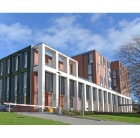The UK’s largest Passivhaus non- residential building

The recently completed £42 million Centre for Medicine at the University of Leicester has become the largest non-residential facility in the UK to achieve the Passivhaus standard. Designed by Associated Architects, the Centre for Medicine will record a -2 energy-performance asset rating, placing it in the A+ category.
Dave Vernon, operations manager with construction and property services company Willmott Dixon, says, ‘Delivering a Passivhaus on such a large scale is not without its challenges, and we employed a number of energy-efficient mechanisms to ensure that this standard was met.
‘The building boasts many intelligent energy features, including a ground-to-air heat-exchange system, active solar shading and embedded soffit cooling, which aids in the reduction of energy used within the building.’
Dave Vernon, project manager at the University of Leicester, said, ‘Users from the College of Medicine, Biological Sciences and Psychology have been heavily involved in the design of the building and through our soft-landings process are fully engaged in learning how to work in such an innovative building. Many of the myths surrounding Passivhaus buildings have been dispelled, and users are now energised and excited about the imminent move.’
Engineering consultant was Couch Perry Wilkes.







